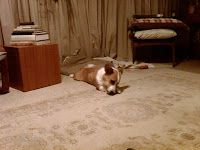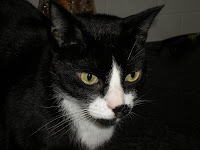 Last week, Poppy and I went to puppy kindergarten for the first time! We are going back for our second class tonight. The most beneficial aspect of the class was exposing her to other puppies and people. It was interesting for me to listen to the advice the trainer had and I learned quite a bit.
Last week, Poppy and I went to puppy kindergarten for the first time! We are going back for our second class tonight. The most beneficial aspect of the class was exposing her to other puppies and people. It was interesting for me to listen to the advice the trainer had and I learned quite a bit.We worked on handling, so the puppies would get used to someone looking at their paws, in their ears, around their tails, and exams in general. This training is especially helpful when you bring your puppy to the vet; it enables your veterinarian to perform a thorough physical exam. Poppy was of course an angel and behaved perfectly; apparently she is only a terror at home, when she races around chewing on everything in sight!
Last week I boostered Poppy with her distemper/parvo vaccine and started her Leptospirosis (Lepto) vaccine series. While the Lepto vaccine is not considered one of the core vaccines, I do recommend that all dogs receive it.
Lepto is a bacteria transmitted via the urine of an infected animal, most commonly wildlife such as rats, opossums and raccoons. These animals urinate in standing water or moist soil where the Lepto bacteria replicate and can live for quite some time. Your dog then comes along and either drinks the contaminated water or steps in the puddle, which allows the bacteria to enter the blood stream through a cut in the skin or through mucus membranes such as eyes, mouth, or nose. People can become infected with Lepto either through contaminated water or via contact with the urine of an infected animal.
Though Lepto can be treated with antibiotics, if the infection is not caught early enough it can permanently damage the kidneys and/or liver, resulting in organ failure. Clinical signs include non-specific flu-like symptoms such as fever, lethargy, decreased appetite, vomiting, and diarrhea. With aggressive therapy consisting of intravenous fluids and antibiotics, dogs usually recover. But in some cases, the disease is too advanced by the time we catch it and ends up being fatal.

Wondering if your dog should be vaccinated? Talk with your veterinarian. Dogs of any age can be given the Lepto vaccine. Bear in mind, that though the vaccination protects against the four most common strains of Lepto, a vaccinated pet can still be infected with one of the many other strains of the bacteria. And, as with all vaccines, there is the risk of a vaccine reaction, something you’ll want to discuss with your veterinarian as well.
I strongly recommend the Lepto vaccine for all my canine patients, and my own dogs are vaccinated, too. I frequently take my dogs to the park and trails in my neighborhood, and feel much more comfortable knowing that I’ve done everything I can to protect them.














 I spend time working with Poppy every day and incorporate the training methods into daily activities. For example, before she gets her dinner she must sit, wait for me to place it down and then call her. Before I put her leash on she must sit calmly and allow me to attach the leash before we go anywhere. Performing activities such as these shows her how to behave appropriately and not act like a wild thing. This is something Poppy and I work hard on and while she is very bright we have setbacks and I have to constantly remember to take time to teach her correctly. Next week we will cover the remaining three basic commands for a well behaved puppy.
I spend time working with Poppy every day and incorporate the training methods into daily activities. For example, before she gets her dinner she must sit, wait for me to place it down and then call her. Before I put her leash on she must sit calmly and allow me to attach the leash before we go anywhere. Performing activities such as these shows her how to behave appropriately and not act like a wild thing. This is something Poppy and I work hard on and while she is very bright we have setbacks and I have to constantly remember to take time to teach her correctly. Next week we will cover the remaining three basic commands for a well behaved puppy.
 Monthly heartworm prevention is essential year round for both dogs and cats, even indoor kitties. There is NO treatment for heartworm in cats, and sudden death is a common result of heartworm infections. While it’s true that infected dogs can be treated, the treatment itself is very dangerous—and can even be fatal. Left untreated, heartworm disease will kill a dog.
Monthly heartworm prevention is essential year round for both dogs and cats, even indoor kitties. There is NO treatment for heartworm in cats, and sudden death is a common result of heartworm infections. While it’s true that infected dogs can be treated, the treatment itself is very dangerous—and can even be fatal. Left untreated, heartworm disease will kill a dog.


 Each time before I put Poppy in the crate and immediately when I let her out, I take her outside so she can go to the bathroom. Instinctively most dogs will not urinate or defecate in the same space they sleep in, thus she should “hold it” while in the crate. When Poppy goes to the bathroom outside I lavish her with praise—as if this was the best thing in the world she could possibly have done! This seems to be enough for Poppy, but for some dog owners using a small treat as a reward works well too.
Each time before I put Poppy in the crate and immediately when I let her out, I take her outside so she can go to the bathroom. Instinctively most dogs will not urinate or defecate in the same space they sleep in, thus she should “hold it” while in the crate. When Poppy goes to the bathroom outside I lavish her with praise—as if this was the best thing in the world she could possibly have done! This seems to be enough for Poppy, but for some dog owners using a small treat as a reward works well too.





